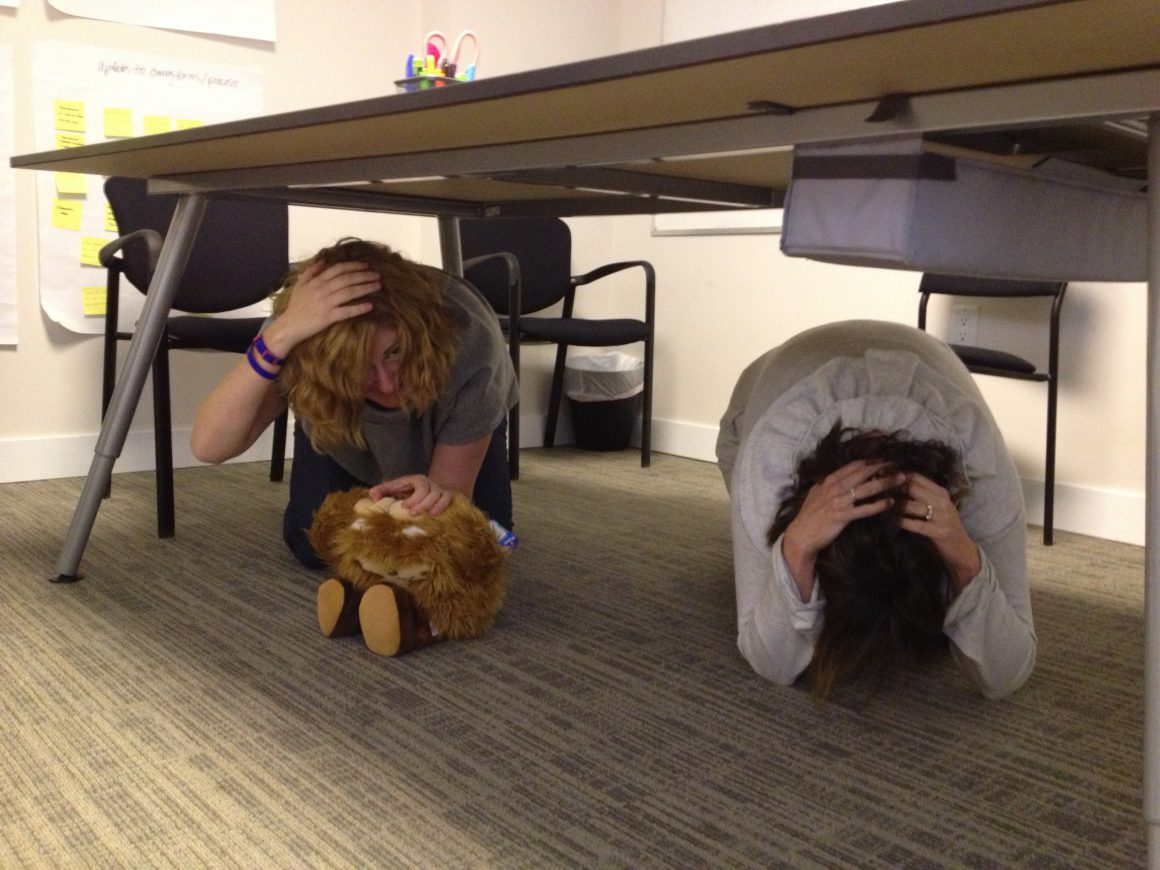Did you know that an estimated 500,000 earthquakes occur each year, 100,000 of which can be felt? Whether you have children, pets or seniors living in your home, practicing earthquake drills and creating plans for each household member can provide peace of mind, while making your family’s safety top priority. Plus, preparing for an earthquake will help you prepare for any type of unexpected event!
To get you started, we’ve put together five ways to get any member of your family Shakeout-ready:
1. Practice “Drop, Cover & Hold On”
On Thursday October 20th, millions of people around the world will practice how to “Drop, Cover, and Hold On” during the Great Shakeout earthquake drills. Knowing how to “Drop, Cover & Hold On” is the best way to reduce your risk of injury.
- Drop: Get to the ground as soon as you feel shaking. Stay low, and cover your head and neck as much as possible
- Cover: Moving under a sturdy desk or table will help reduce the risk of flying or falling objects reaching you.
- Hold On: It’s likely that whatever you are holding on to will shift during the earthquake. Hold on tight and do your best to wait for at least 60 seconds once the shaking has stopped to allow unstable things time to settle
Should you find yourself outside of your home or office during an earthquake, check out Shakeout’s safety guide for a variety of other scenarios to prepare for.
2. Make Emergency Preparedness Fun for Kids
Involving your children in emergency preparedness helps them understand and also creates peace of mind for them. One of our favorite things to do is to run active games to make preparedness a bit more fun. Girl Guides of Canada suggests Earthquake Tag, where one child is the “Earthquake” and tries to catch the other children who cannot run. They can prevent getting caught by practicing Drop, Cover & Hold On, and counting down from 60. Any child caught, joins the Earthquake in catching others
For older, or more tech-savvy kids, they can try interactive online games to test their earthquake preparedness knowledge:
- Be A Hero…and Build A Kit! Join Gayle and her friends in gathering supplies needed to prepare for an emergency
- Beat the Quake – Learn how to help make your home a safe space during an earthquake
3. Ensure Elderly Parents Have a Plan
In addition to the standard items in their 72-hour emergency kit, seniors should consider the following:
- Medication and medical supplies: Where possible keep a week’s supply of medication on hand as well as prescription and dosage information
- Additional personal items: Keep extras of anything necessary for personal needs, such as eyeglasses, hearing aids and batteries, wheelchair batteries, oxygen, and copies of medical insurance information.
- Service animal or pet plans: In the event of an evacuation, consider loved ones or pet-friendly shelters outside of the area that pets can be housed with (emergency shelters may often only take service animals)
For a complete plan to prepare the seniors in your life, download FEMA’s checklist here.
4. Protect Your Pet In An Earthquake
During an earthquake, your pets will rely on you to keep them safe. Once you have ensured your own safety, pick up your pet and hold them to your chest as you “Drop, Cover and Hold On” (only do so if your pet is comfortable being held). If they are already in a carrier or crate, leave them in it as it will protect your pet from falling debris
And once the shaking has stopped, clear an area around a safe space for your pet, or place them in a crate. Prepared BC has a complete guide to preparing your pets for emergencies.
5. Secure Your Home
There are plenty of small adjustments you can make to ensure that your home is seismically prepared!
- Use furniture brackets or straps to prevent bookcases, entertainment systems, and appliances from falling or moving around
- Consider moving hanging wall items from around beds, couches and chairs, or securing them with closed hooks or poster putty
- If you have a hot water tank in your home, fasten it to the wall to avoid it snapping the gas line and to give you a usable water supply source
For more information, take a look through Shakeout’s Tips for Safer Surroundings.
We hope these tips will help you and your family prepare for and recover quickly from any earthquake. Be sure to connect with us on Twitter or Facebook if you have any earthquake preparedness questions or if you have your own tips you would like to share!
Terms and Conditions
All content provided on this blog is for informational purposes only. The owner of this blog makes no representations as to the accuracy or completeness of any information on this site or found by following any link on this site. The owner will not be liable for any errors or omissions in this information nor for the availability of this information. The owner will not be liable for any losses, injuries, or damages from the display or use of this information. This policy is subject to change at anytime.

